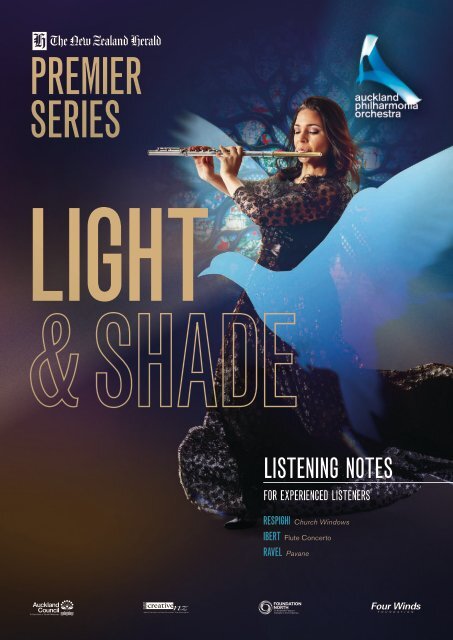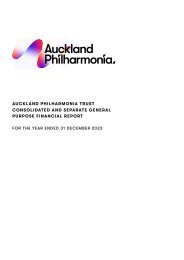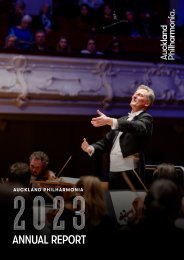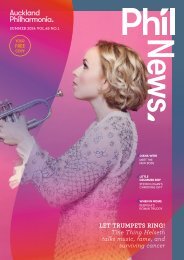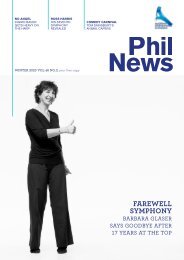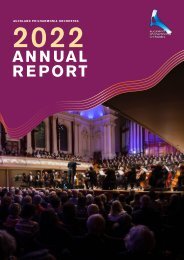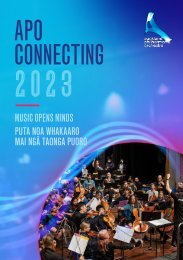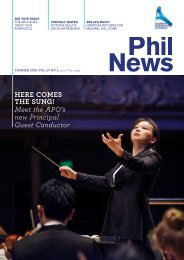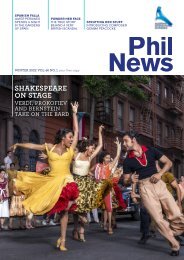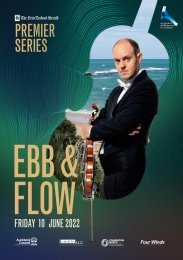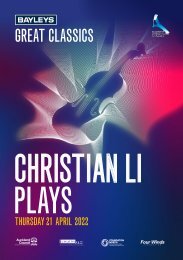Create successful ePaper yourself
Turn your PDF publications into a flip-book with our unique Google optimized e-Paper software.
PREMIER<br />
SERIES<br />
LIGHT<br />
& SHADE<br />
LISTENING NOTES<br />
FOR EXPERIENCED LISTENERS<br />
RESPIGHI Church Windows<br />
IBERT Flute Concerto<br />
RAVEL Pavane
OTTORINO<br />
RESPIGHI<br />
(1879 – 1936)<br />
COMPOSER PROFILE<br />
• Born in Bologne, Italy in 1879<br />
• Taught piano by his father, who was a piano teacher<br />
• He also studied violin, viola, composition (with<br />
Rimsky-Korsakov), and music history<br />
• Moved to St. Petersburg, Russia when he was 20, and<br />
joined the Russian Imperial <strong>The</strong>atre as Principal Violin<br />
• When he was 34, he moved to Rome to teach<br />
composition. He remained there for the rest of his life<br />
• By the mid-1920s, he achieved world fame and<br />
toured extensively<br />
CHURCH WINDOWS<br />
This suite was based on three piano pieces that<br />
Respighi also composed, during a time when he was<br />
heavily inspired by Gregorian chanting. He uses this<br />
sonorous vocal style with the orchestra. This suite has<br />
four movements.<br />
I. <strong>The</strong> Flight into Egypt<br />
II. St. Michael the Archangel<br />
III. <strong>The</strong> Matins of St. Clare<br />
IV. St. Gregory the Great<br />
<strong>The</strong> opening movement, <strong>The</strong> Flight into Egypt (Molto<br />
lento, D Minor) is very slow and in five time. It gently<br />
pulses and uses a stepwise melody, common in medieval<br />
music. His use of musical scales creates an exotic<br />
feeling, and the slow five time is used to illustrate the<br />
uneven steps of the slaves escaping from Egypt.<br />
<strong>The</strong> next movement, St. Michael the Archangel (Allegro<br />
impetuoso, D Minor) is impetuous and fast, and in two<br />
time. It represents a battle with a dragon in the sky; and<br />
the sounds of weapons clashing. <strong>The</strong> trombone is used<br />
to play his first theme in this movement, against a horn<br />
fanfare and the strings playing descending, chromatic<br />
scales. A second theme enters, played by the horns and<br />
strings. A slow section follows this, played off stage by<br />
a solo trumpet before the sky battle starts up again and<br />
finishes with a huge crash at fff on the tam-tam<br />
(a gong-like type of percussive instrument).<br />
<strong>The</strong> Matins of St. Clare (Lento, F# Minor) is very slow<br />
and in five time. This movement is calm and peaceful<br />
compared to the previous one. It opens softly with a pedal<br />
note in the horns and violas and a melody in the flutes<br />
and oboes. He also uses bells to recreate the monastery<br />
image fully. <strong>The</strong> movement also changes key from minor<br />
to major, creating an uplifting, rapt feeling.<br />
<strong>The</strong> final movement, St. Gregory the Great (Lento, Ab<br />
Major) is very slow and in four time. This movement was<br />
inspired by Gloria from the Missa Angelica (Angelic Mass).<br />
It opens quietly with bell-like figures and the horns playing<br />
the Gregorian chant. This movement also includes an<br />
organ solo which takes the movement to a climax before<br />
the brass section reprises the Gloria motif and brings the<br />
piece to a grand finale.<br />
DID YOU KNOW?<br />
Elsa Respighi, Ottorino’s wife, was also a composer. She<br />
was only 41 when he died, and being 15 years younger;<br />
she lived on for another 60 years, dying one week short of<br />
her 102nd birthday.<br />
2
JACQUES<br />
IBERT<br />
(1890 – 1962)<br />
COMPOSER PROFILE<br />
• Born in Paris, France in 1890<br />
• His mother was an accomplished pianist<br />
• She provided him with piano and violin lessons, but<br />
Ibert decided he wanted to be a composer<br />
• After graduating high school, Ibert went to work for his<br />
father’s struggling business<br />
• While working there, he met many actors, singers and<br />
writers and he developed an interest in theatre which<br />
would remain throughout his life<br />
• When he began studying music, his father withdrew<br />
financial support<br />
• Ibert made money working as an accompanist and<br />
composing piano pieces and songs<br />
• He was an excellent improviser and became an<br />
accompanist for silent movies in theatres, which led<br />
him to compose over sixty film scores later in his life<br />
FLUTE CONCERTO<br />
Ibert’s Flute Concerto was composed in 1934 and it was<br />
dedicated to the great French flautist Marcel Moyse. This<br />
piece is considered one of the most difficult pieces in the<br />
flute repertoire.<br />
<strong>The</strong> Flute Concerto is composed of three movements:<br />
I. Allegro<br />
II. Andante<br />
III. Allegro Scherzando<br />
<strong>The</strong> first movement, Allegro is in two time and it opens<br />
with a short four-bar introduction before the solo flute<br />
enters with rapid running passes and very few chances<br />
to breathe. <strong>The</strong> orchestra briefly takes over the fast<br />
passages, and the flute also engages in question and<br />
answer with other instruments. This movement rushes<br />
headlong to a final loud chord at ff.<br />
Andante is lyrical and in three time. It uses the full range<br />
of the flute, and it opens with a blues-influenced melody<br />
punctuated occasionally by the timpani. <strong>The</strong>re is tension<br />
and resolution in this movement underlying a poignant<br />
melody. Ibert’s wife once commented that the Concerto<br />
had been written shortly after the death of Ibert’s father<br />
and that this movement expressed a spirit of mourning<br />
and reflection.<br />
<strong>The</strong> final movement, Allegro Scherzando is in multiple<br />
times. It once again shows off the virtuosic ability of the<br />
solo flute. It contains jazz-influenced rhythm, fanfares<br />
and two improvised solos. <strong>The</strong> final solo is followed by<br />
the entire orchestra playing together and it brings the<br />
Concerto to a climactic conclusion.<br />
DID YOU KNOW?<br />
During World War I, Ibert joined an army medical unit and<br />
was decorated with the Croix de Guerre by the French<br />
government.<br />
3
JOSEPH<br />
MAURICE RAVEL<br />
(1875 – 1937)<br />
COMPOSER PROFILE<br />
• Born in the town of Ciboure, France – very close to the<br />
Spanish border<br />
• Won a place at the Paris Conservatoire at the age of 14<br />
• His first work was published when he was 20<br />
• He studied with composer Gabriel Fauré<br />
• His music was influenced by Spanish colour and rhythm<br />
• In 1928, after touring the USA, he was awarded an<br />
honorary Doctorate from Oxford University<br />
• Ravel battled Pick’s Disease in the last few years of his<br />
life, which increasingly affected his speech and motor<br />
control<br />
• After an unsuccessful operation in 1937, he passed away<br />
PAVANE<br />
A pavane was a stately dance from the Renaissance<br />
period, used to open ceremonial balls put on by the<br />
aristocrats. <strong>The</strong> slow, processional nature of the music<br />
allowed the dancers to show off their elegant ball gowns.<br />
<strong>The</strong> sense of longing and tenderness, so compellingly<br />
captured in Ravel’s Pavane pour une enfante défunte, was<br />
inspired by his beloved mother, Marie. From the Basque<br />
country, she would often sing him Basque folksongs,<br />
sparking a deep sympathy and love for his mother’s<br />
people and folklore.<br />
<strong>The</strong> title of the work is the source of some confusion.<br />
In translation, it means ‘Pavane for a dead princess’,<br />
but it wasn’t intended as a sad musical vignette. Rather,<br />
Ravel was drawn to the imaginative world of the Spanish<br />
17th-century painter Diego Velázquez. <strong>The</strong> noble and<br />
graceful pavane, as Ravel explains, ‘is not a funeral lament<br />
for a dead child but rather an evocation of the pavane<br />
that might have been danced by such a little princess as<br />
painted by Velázquez.’<br />
Ravel originally composed the Pavane pour une enfant<br />
défunte in 1899 as a piece for solo piano. This beautiful<br />
and simple work became an immediate favourite.<br />
However, pianists often played it slowly, transforming the<br />
pavane into a deathly dirge, prompting Ravel to exclaim ‘It<br />
was the princess who dies, not the pavane!’ Many critics<br />
agree that Ravel’s careful orchestration of the work in<br />
1910 was an improvement.<br />
<strong>The</strong> Pavane begins with a long-breathed horn melody<br />
that gives way to a sunlit, pastoral oboe entry followed by<br />
quietly nostalgic strings, then the tune makes its pulsating<br />
reappearance, this time on the woodwinds. <strong>The</strong>re’s a<br />
drifting passage with strings, harps and flutes before the<br />
theme makes its last entrance, every instrument bearing it<br />
aloft, as though it were being gently carried shoulder-high<br />
during a sad funeral procession.<br />
DID YOU KNOW?<br />
Ravel’s most famous piece is arguably Boléro, which<br />
skaters Torvill and Dean used to accompany their goldmedal<br />
winning ice dance at the Olympic Games in 1984.<br />
It was originally written as a piano accompaniment to a<br />
ballet. Ravel himself said of the work, ‘it has no music<br />
in it’ and was surprised by its widespread success and<br />
popularity.<br />
4


